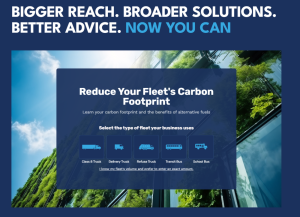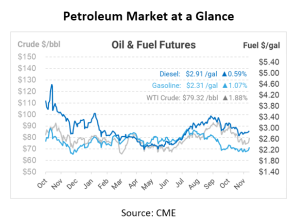
Want to Reduce Your Fleet’s Carbon Footprint? Start Here
In today’s world, the importance of environmental awareness and sustainability cannot be overstated. Businesses across different industries recognize their role in mitigating climate change and are taking steps to reduce their environmental impact. The transportation industry is no exception. An important aspect of this journey is understanding and actively addressing your fleet’s Carbon Footprint.
Whether you manage a small delivery service or a large transportation company, taking steps to reduce your fleet’s emissions is not just a moral obligation; it’s also a smart business move. To calculate your carbon emissions, start by measuring fuel consumption, vehicle types, number of assets, and distances traveled. Does it sound too complicated? The good news is Mansfield Energy offers a new user-friendly calculator, enabling you to estimate emissions and identify areas where improvements can be made. Through the calculator, you can learn your carbon footprint and the benefits of alternative fuels.
What is a carbon footprint?
A carbon footprint refers to the total amount of greenhouse gases (GHGs), primarily carbon dioxide (CO2), and other emissions produced directly or indirectly by a company. It is a crucial metric for evaluating the environmental impact of an operation or product. You can learn more about Carbon Footprint here.
Mansfield Solution
To learn more, access the calculator on Mansfield Energy website. Then, inform the type of fleet your business uses and how many vehicles you have in your fleet. You can also include your fleet’s annual diesel volume to get an even more tailored answer.

Once you have a clear understanding of your fleet’s carbon footprint, you can take the next steps to address and reduce emissions. If you are unsure how to start it, Mansfield experts can also provide you with a comprehensive sustainability strategy tailored to your fleet’s specific needs and goals.
In our next article, we’ll also talk about practical ways to reduce emissions from your fleet. We’ll share strategies that you can easily implement to make your fleet more eco-friendly. Whether it’s using cleaner fuels, adopting new technologies, or changing how you operate, we’ll provide you with simple steps to make your fleet greener and save money. Stay tuned for these practical tips!

This article is part of Daily Market News & Insights
Tagged:
MARKET CONDITION REPORT - DISCLAIMER
The information contained herein is derived from sources believed to be reliable; however, this information is not guaranteed as to its accuracy or completeness. Furthermore, no responsibility is assumed for use of this material and no express or implied warranties or guarantees are made. This material and any view or comment expressed herein are provided for informational purposes only and should not be construed in any way as an inducement or recommendation to buy or sell products, commodity futures or options contracts.





